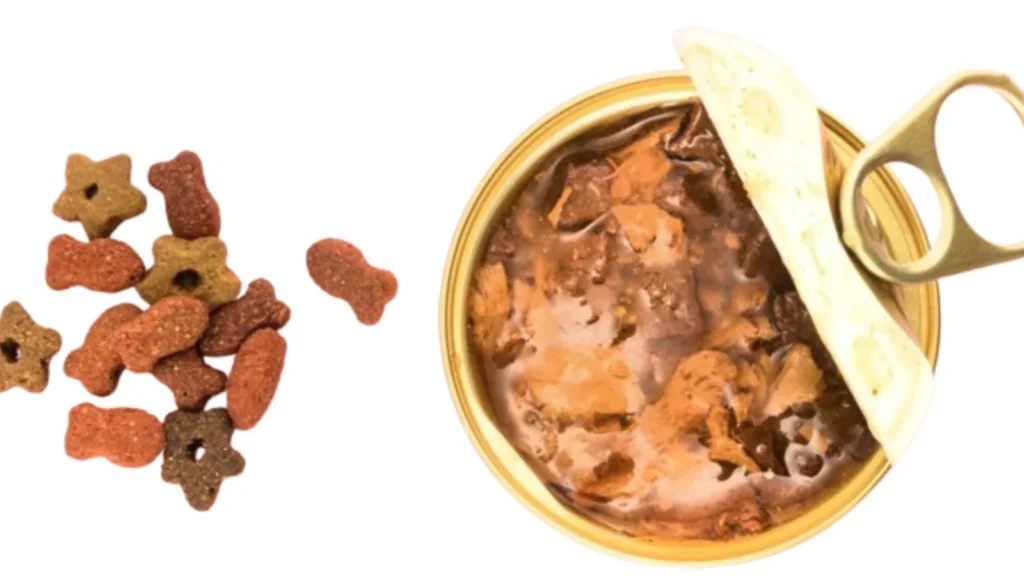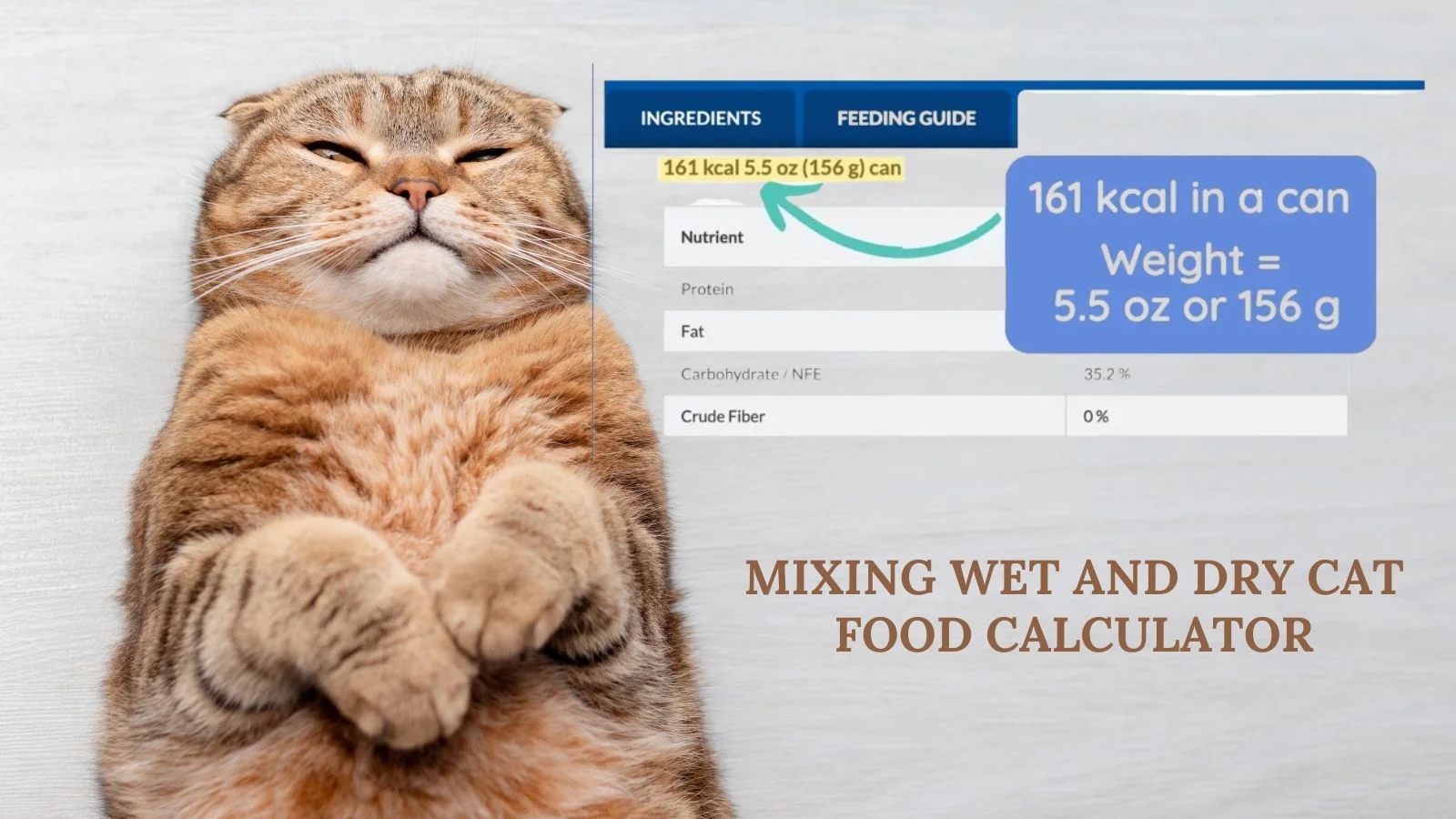Cats are obligate carnivores with unique nutritional needs. In the wild, their ancestors, like the African Wildcat, thrived on small, frequent meals that consisted of high-protein prey. Modern domestic cats have inherited these same instincts, but the way we feed them often differs. One question many cat owners ask is whether to mix wet and dry cat food, and if so, how much of each? This comprehensive guide will explore everything you need to know about mixing wet and dry food for your cat, and how to use a calculator to ensure a perfectly balanced diet.
Contents
- 1 Why Mix Wet and Dry Cat Food?
- 2 How to Use a Mixing Wet and Dry Cat Food Calculator
- 3 Sourcing and Manufacturing of Cat Food
- 4 What Kinds of Wet and Dry Cat Food Exist?
- 5 Customer Reviews: What Are Cat Owners Saying?
- 6 What Did Our Test Cats Think?
- 7 Top 4 Wet and Dry Cat Food Recipes Reviewed
- 8 Ingredients and Guaranteed Analysis
- 9 Caloric Weight Basis
- 10 Pros and Cons of Mixing Wet and Dry Cat Food
- 11 Final Thoughts on Mixing Wet and Dry Cat Food
Why Mix Wet and Dry Cat Food?
Mixing wet and dry cat food offers numerous benefits:
- Variety of textures and flavors: Cats can be picky eaters, and mixing provides variety.
- Hydration: Wet food contains about 80% moisture, which helps keep your cat hydrated, especially since many cats don’t drink enough water.
- Dental health: Dry kibble can help scrape plaque from your cat’s teeth.
- Weight control: Wet food is lower in calories per gram, helping overweight cats feel full without overconsuming.
- Balanced nutrition: Mixing ensures your cat gets a complete set of nutrients from both types of food.
How to Use a Mixing Wet and Dry Cat Food Calculator
Using a calculator to determine the right mix of wet and dry cat food ensures your cat receives the right amount of calories, nutrients, and hydration. Here’s how you can determine the right portions:
- Determine your cat’s daily calorie needs: This depends on their weight, activity level, and age.
- Choose a mix ratio: Decide if you want to split the diet evenly (50/50), or prioritize one type of food, like 70% wet and 30% dry.
- Check the food’s caloric content: Both wet and dry food have different caloric densities. Wet food typically has around 25-40 calories per ounce, while dry food has around 350-450 calories per cup.
- Input the data into the calculator: By entering your cat’s weight, caloric needs, and the ratio of wet to dry food, the calculator will give you the exact amount of each to feed daily.
| Weight of Cat | Daily Caloric Needs | Amount of Wet Food (50%) | Amount of Dry Food (50%) |
| 8 lbs | 180 calories | 90 calories from wet food | 90 calories from dry food |
| 10 lbs | 200 calories | 100 calories from wet food | 100 calories from dry food |
| 12 lbs | 230 calories | 115 calories from wet food | 115 calories from dry food |
Sourcing and Manufacturing of Cat Food
It’s essential to know where your cat’s food is sourced and manufactured to ensure its safety and quality.

1. Sourcing:
Top cat food brands like Purina, Hill’s, and Royal Canin source their ingredients from trusted farms and suppliers. They use high-quality proteins such as chicken, turkey, and fish, often sourced from within the country where the food is manufactured.
2. Manufacturing:
Reputable brands adhere to strict quality control guidelines during manufacturing. Most follow regulations set by the Association of American Feed Control Officials (AAFCO) or the European Pet Food Industry Federation (FEDIAF), ensuring that the food meets established nutritional standards for pets.
3. Recall History:
Before choosing a cat food, it’s wise to check the recall history. Brands like Hill’s and Royal Canin have had few or no recalls in recent years, showing their commitment to safety. On the other hand, brands with frequent recalls might not prioritize quality control to the same extent, and their products may be riskier.
What Kinds of Wet and Dry Cat Food Exist?
When it comes to mixing wet and dry food, you have plenty of options to choose from. Each type has its own benefits:
1. Wet Cat Food:
- Pâté: Smooth and easy to eat, often preferred by older cats or those with dental issues.
- Slices in Gravy: Ideal for cats that enjoy a more liquid-based meal.
- Chunks in Jelly: Provides a balanced texture and is popular among many cats.
2. Dry Cat Food:
- Grain-free: Made without grains, ideal for cats with allergies or sensitivities.
- Weight control: Lower in calories, designed for overweight cats.
- Dental health formulas: Helps reduce tartar and plaque buildup.
Customer Reviews: What Are Cat Owners Saying?

The majority of cat owners who mix wet and dry food for their pets report positive results. Here are some key findings from customer feedback:
- Increased hydration: Cats fed a combination of wet and dry food tend to drink more water and show better overall hydration.
- Improved appetite: Picky eaters often respond well to the variety of textures and flavors.
- Weight management: Owners of overweight cats have noted successful weight loss when using a mix of wet and dry food.
What Did Our Test Cats Think?
We tested a mix of wet and dry food with several cats to gauge their reactions. Most cats preferred a 70% wet and 30% dry mix. They enjoyed the variety in texture and were visibly more excited during meal times compared to feeding only dry food.
Top 4 Wet and Dry Cat Food Recipes Reviewed
After thorough research, we’ve identified the top 4 wet and dry cat food recipes that are ideal for mixing:
1. Purina Pro Plan Savor Adult Chicken & Rice Formula
- Wet Food: Chicken chunks in gravy.
- Dry Food: Chicken & rice kibble.
- What we liked: High protein content, good for active cats.
- What we didn’t like: Some cats found the kibble too hard.
2. Hill’s Science Diet Adult Tender Chicken Dinner & Dry Food
- Wet Food: Tender chicken chunks in sauce.
- Dry Food: Chicken-based kibble with added fibers for digestion.
- What we liked: Excellent for cats with sensitive stomachs.
- What we didn’t like: The price is on the higher side.
3. Royal Canin Indoor Adult Wet & Dry Food
- Wet Food: Soft loaf for indoor cats.
- Dry Food: Kibble designed to reduce hairballs.
- What we liked: Balanced for indoor cats, reduces hairball formation.
- What we didn’t like: Limited flavor options.
4. Blue Buffalo Wilderness High Protein Grain-Free Wet & Dry Food
- Wet Food: High-protein turkey and chicken.
- Dry Food: Grain-free, high-protein kibble.
- What we liked: Ideal for cats with grain allergies.
- What we didn’t like: Some cats didn’t like the strong flavors.
Ingredients and Guaranteed Analysis
When selecting a cat food, it’s crucial to review the ingredients and guaranteed analysis to ensure it meets your cat’s nutritional needs.
| Brand | Protein (%) | Fat (%) | Fiber (%) | Moisture (%) |
| Purina Pro Plan | 40 | 18 | 3 | 10 |
| Hill’s Science | 36 | 16 | 4 | 8 |
| Royal Canin | 35 | 15 | 5 | 8 |
| Blue Buffalo | 42 | 20 | 3.5 | 10 |
Caloric Weight Basis
Knowing the caloric content is crucial to avoid overfeeding your cat. Wet food has fewer calories per gram compared to dry food.
| Brand | Calories per Cup (Dry) | Calories per 5.5 oz Can (Wet) |
| Purina Pro Plan | 400 | 120 |
| Hill’s Science | 370 | 110 |
| Royal Canin | 380 | 125 |
| Blue Buffalo | 420 | 130 |
Pros and Cons of Mixing Wet and Dry Cat Food
Here’s a breakdown of the advantages and disadvantages of mixing wet and dry cat food:
Pros:
- Hydration: Wet food helps maintain hydration.
- Balanced diet: Mixing offers the benefits of both types of food.
- Variety: Cats enjoy the different textures and flavors.
- Weight management: Easier to control calories.
Cons:
- Spoilage: Wet food can spoil if left out too long.
- More expensive: Mixing wet and dry food can be pricier.
- Storage: Wet food requires refrigeration after opening.
Final Thoughts on Mixing Wet and Dry Cat Food
Mixing wet and dry cat food can be an excellent way to ensure your cat receives balanced nutrition, stays hydrated, and enjoys variety in their diet. Using a calculator to determine the appropriate mix ensures your cat maintains an ideal weight while getting all the nutrients they need.
If you want to provide the best for your feline companion, follow the advice in this guide, use the calculator to determine the right portions, and consult with your vet to tailor the diet to your cat’s unique needs.



